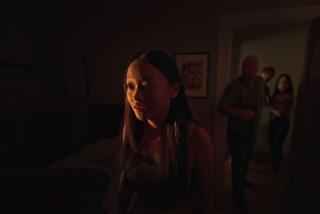Those paranoid feelings are back
- Share via
Throughout the 1970s, a growing fear gnawed at the hearts and uneasy minds of Americans, the suspicion that no one could be trusted -- not big business, not authority figures, not society in general. Especially not the government. And filmmakers -- both emerging and established -- often brilliantly captured the turbulent decade’s paranoia.
For the next month, the Los Angeles County Museum of Art’s film department is spotlighting the “Paranoia Films of the ‘70s.” The festival opens Friday with Francis Ford Coppola’s landmark 1974 thriller “The Conversation,” starring Gene Hackman as a secretive San Francisco surveillance expert who believes a young couple he was hired to spy on will be murdered; and Arthur Penn’s 1975 mystery thriller “Night Moves,” with Hackman as a former football player and private eye hired on what he believes is a standard missing-person case.
Other films included in the retrospective are 1974’s “The Parallax View,” directed by Alan J. Pakula and starring Warren Beatty; Roman Polanski’s 1976 thriller “The Tenant”; Sydney Pollack’s 1975 chiller “Three Days of the Condor,” with Robert Redford; Steven Spielberg’s classic 1971 TV movie “Duel”; Martin Scorsese’s expressionistic 1976 drama “Taxi Driver”; and Sam Peckinpah’s 1971 revenge drama “Straw Dogs,” with Dustin Hoffman.
Chris Horak, curator of the Hollywood Entertainment Museum, traces the paranoia of the ‘70s to a convergence of factors in the previous decade. “It was more than just the John F. Kennedy assassination,” he says. “It was more than Vietnam and more than just the civil rights movement, which you have to take into consideration. During the civil rights movement, a lot of Americans saw government, state governments, breaking the law” and acting on agendas that ignored the best interests of the people. “It was shocking.”
Extending boundaries
Also coming into play was the demise of the Hays Production Code, which had censored Hollywood since the 1930. By 1966, it was basically defunct, and veteran filmmakers found themselves in competition with a freewheeling new group of directors, including Coppola, Scorsese and Spielberg, who were willing and eager to expand the boundaries of film.
“The filmmakers who are making the films in the series are either complete Hollywood outsiders, like Spielberg, or came from television or had been in the lower level of ‘B’ films, like Peckinpah, but by the late ‘60s and early ‘70s were coming into the fore,” says Horak.
“This new generation is much more willing to question authority not only in the public form but also how films are to be made -- the films don’t conform to a classical Hollywood narrative in the same way.”
And the actors who starred in these films -- Robert De Niro, Al Pacino and Hoffman -- didn’t look like classic matinee idols. “It was an era where the actors became a lot more like ordinary-looking people,” says LACMA film curator Ian Birnie. “Their own physical appearance and their interest in way-out psychology made it possible to create these kind of characters.”
Though some of the protagonists in these paranoia films were decent guys who found themselves embroiled in some conspiracy, like Redford in “Condor” and Beatty in “Parallax View,” most were more like Hackman’s dark and unsympathetic Harry Caul in “The Conversation.”
“He is not nominally somebody who would be the hero of a film,” says Oscar winner Walter Murch, who edited “The Conversation” as well as created the thriller’s landmark sound design. “That is precisely what Francis was interested in -- taking somebody who in a normal murder mystery would have a tangential role and switching lenses and looking at this character exclusively.”
When a film is about an unusual person who has an unusual occupation, says Murch, “and it is told completely from their point of view, you begin, if you stick with the film, to see and in this case hear the world the way this person hears it. Because this person is a professional sound person you begin to become one too. I think that is why people pick up that the sound is so important and critical in the film.”
These films, says Birnie, “kind of mark the beginning of our modern world. Our lives kind of got divided into two: Our childhood was lived in a kind of world that wasn’t that much different from ‘Meet Me in St. Louis’ and our adulthood was totally different.”
*
(BEGIN TEXT OF INFOBOX)
Paranoia Films of the ‘70s
Where: Los Angeles County Museum of Art, Leo S. Bing Theatre, 5905 Wilshire Blvd.
When: 7:30 p.m. Fridays and Saturdays through April 2
Price: $6 to $9.
Contact: (323) 857-6000
Schedule
Friday: “The Conversation,” “Night Moves”
Saturday: “The Parallax View,” “Who’ll Stop the Rain?”
March 18: “The Tenant,” “Images”
March 19: “Three Days of the Condor,” “Duel”
March 25: “Klute,” “Cruising”
March 26: “Straw Dogs,” “Taxi Driver”
April 1: “Invasion of the Body Snatchers,” “Assault on Precinct 13”
April 2: “Blow Out,” “Cutter’s Way”
More to Read
Only good movies
Get the Indie Focus newsletter, Mark Olsen's weekly guide to the world of cinema.
You may occasionally receive promotional content from the Los Angeles Times.











